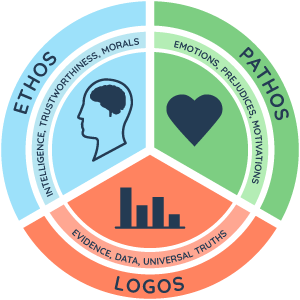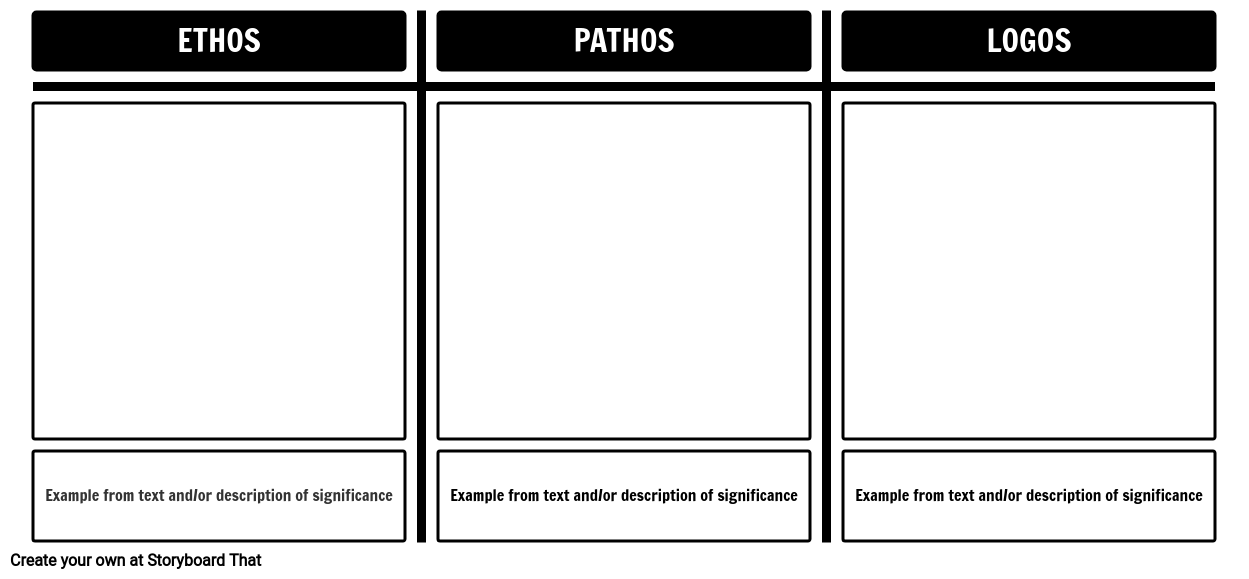Activity Overview
In high school, students start to develop formal writing skills, creating essays and arguments that are well-thought-out, and syntactically varied. Students also need to effectively use persuasive writing strategies to defend a claim or point of view.
A key to strong persuasive writing the ability to dissect and validate, or debunk, other arguments. This requires a basic working knowledge of rhetoric. A great way to enhance students' understanding of effective arguments is to teach the Aristotelian concepts of Ethos, Pathos, and Logos. Students can then identify and analyze the effectiveness of these strategies in a work of literature, a speech, or a letter.
Having students create storyboards that show examples of Ethos, Pathos, and Logos is a great way to introduce and teach basic rhetoric in the classroom! Then, have them create a storyboard with 2-3 examples of each of the following types of rhetorical appeals from “Letter from a Birmingham Jail.”
Examples of Rhetorical Strategies in “Letter from a Birmingham Jail”
Ethos/Expertise
“I have the honor of serving as president of the Southern Christian Leadership Conference, an organization operating in every southern state, with headquarters in Atlanta, Georgia. We have some eighty-five affiliated organizations across the South, and one of them is the Alabama Christian Movement for Human Rights.”
Pathos/Appeal to Emotion
“In deep disappointment I have wept over the laxity of the church. But be assured that my tears have been tears of love. There can be no deep disappointment where there is not deep love. Yes, I love the church. How could I do otherwise?”
Logos/Logic
“Any law that uplifts human personality is just. Any law that degrades human personality is unjust. All segregation statutes are unjust because segregation distorts the soul and damages the personality. It gives the segregator a false sense of superiority and the segregated a false sense of inferiority.”
Template and Class Instructions
(These instructions are completely customizable. After clicking "Copy Activity", update the instructions on the Edit Tab of the assignment.)
Student Instructions
Create a storyboard that shows examples of ethos, pathos, and logos from the text.
- Identify one example for each rhetorical strategy: ethos, pathos, and logos.
- Type the example into the description box under the cell.
- Illustrate the example using any combination of scenes, characters, and items.
Lesson Plan Reference
- [ELA-Literacy/RI/9-10/1] Cite strong and thorough textual evidence to support analysis of what the text says explicitly as well as inferences drawn from the text.
- [ELA-Literacy/RI/9-10/6] Determine an author's point of view or purpose in a text and analyze how an author uses rhetoric to advance that point of view or purpose.
- [ELA-Literacy/RI/9-10/8] Delineate and evaluate the argument and specific claims in a text, assessing whether the reasoning is valid and the evidence is relevant and sufficient; identify false statements and fallacious reasoning.
Rubric
(You can also create your own on Quick Rubric.)
| Proficient 33 Points | Emerging 25 Points | Beginning 17 Points | |
|---|---|---|---|
| Ethos, Pathos, and Logos | The elements of ethos, pathos, and logos are correctly identified and depicted, and an appropriate quote or summary is provided. There are at least 2 examples provided for each rhetorical element. | Most of the elements of ethos, pathos, and logos are correctly identified and depicted, and an appropriate quote or summary is provided. There are at least 2 examples provided for each rhetorical element. | The elements of ethos, pathos, and logos are incorrectly identified and depicted. Quotes and summaries may be missing or too limited. Only one example may have been provided for each rhetorical element. |
| Artistic Depictions | The art chosen to depict the scenes are accurate to the work of literature. Time and care is taken to ensure that the scenes are neat, eye-catching, and creative. | The art chosen to depict the scenes should be accurate, but there may be some liberties taken that distract from the assignment. Scene constructions are neat, and meet basic expectations. | The art chosen to depict the scenes is inappropriate. Scene constructions are messy and may create some confusion, or may be too limited. |
| English Conventions | Ideas are organized. There are few or no grammatical, mechanical, or spelling errors. | Ideas are mostly organized. There are some grammatical, mechanical, or spelling errors. | Ideas may be disorganized or misplaced. Lack of control over grammar, mechanics, and spelling reflect a lack of proofreading. |
How to Connect Ethos, Pathos, and Logos in 'Letter from Birmingham Jail' with Contemporary Issues
Introduction to Rhetorical Strategies and Contemporary Context
Begin the lesson by introducing the concepts of ethos, pathos, and logos, explaining their importance in persuasive writing and speeches. Illustrate these concepts using examples from "Letter from Birmingham Jail." Then, introduce contemporary issues that resonate with the themes of King's letter, such as social justice, civil rights, or modern protest movements, to establish a connection between the letter and current events.
In-Depth Analysis of 'Letter from Birmingham Jail'
Proceed to a detailed analysis of "Letter from Birmingham Jail," with a focus on how King uses ethos, pathos, and logos effectively. Guide students in identifying specific examples in the text where these rhetorical strategies are prominent. Encourage discussions, either in the whole class or in small groups, about how these strategies strengthen King’s arguments and the emotional impact of his letter.
Research and Exploration of Contemporary Issues
Assign students to research contemporary issues that share themes with King's letter, such as inequality, human rights, or relevant social movements. Instruct them to collect current articles, speeches, or social media posts related to their chosen issue, paying particular attention to the use of ethos, pathos, and logos.
Development and Presentation of Comparative Analysis
Instruct students to create presentations that draw comparisons between the use of ethos, pathos, and logos in "Letter from Birmingham Jail" and in their contemporary research findings. Encourage them to incorporate various media in their presentations, like PowerPoint slides, video clips, or creative visual aids. Finish the lesson with student presentations, offering a platform for them to showcase their work. Follow up with a class discussion on the lasting relevance of these rhetorical strategies and their applicability to current societal issues.
Frequently Asked Questions about Ethos Pathos Logos in Letter from Birmingham Jail
Why are ethos, pathos, and logos important in 'Letter from Birmingham Jail'?
The use of ethos, pathos, and logos in Martin Luther King Jr.'s "Letter from Birmingham Jail" is crucial for its effectiveness as a persuasive document. Ethos establishes King’s credibility and moral authority, essential in convincing his audience of his legitimacy as a leader and the righteousness of his cause. Pathos, or emotional appeal, is used to connect with the audience on a human level, evoking empathy and understanding for the plight of African Americans suffering under segregation. This emotional connection is vital in mobilizing support and urging action. Logos, or logical reasoning, is employed to construct coherent, rational arguments against segregation and injustice. King’s logical arguments appeal to the intellect of his audience, persuading them through reason and fact. The balanced combination of these rhetorical strategies not only underscores the legitimacy of King's cause but also makes the letter compelling and convincing, contributing to its historical significance and enduring impact.
Are there any criticisms of King’s use of ethos, pathos, and logos in the letter?
While Martin Luther King Jr.'s use of ethos, pathos, and logos in "Letter from Birmingham Jail" is widely acclaimed for its rhetorical mastery, there have been some criticisms. Some critics argue that King’s strong emotional appeals (pathos) might overshadow the logical aspects (logos) of his arguments, potentially leading to a less balanced persuasion. Others have pointed out that while his ethos is firmly established, it primarily resonates with those who already share his moral views, possibly limiting the letter's persuasive reach to a broader skeptical audience. However, these criticisms are relatively minor when compared to the widespread recognition of the letter's powerful and effective use of rhetorical strategies. The majority view is that King’s skilled balance of ethos, pathos, and logos significantly contributed to the letter’s effectiveness in advancing the civil rights movement.
What types of activities can be included in worksheets to analyze the rhetorical strategies used in the letter?
Worksheets designed to analyze the rhetorical strategies in "Letter from Birmingham Jail" can include a variety of activities. These could start with identification tasks, where students locate and highlight examples of ethos, pathos, and logos in the text. Comparative analysis exercises can encourage students to examine how the different rhetorical strategies are balanced throughout the letter and to evaluate their effectiveness. Critical thinking questions can prompt deeper reflection on how these strategies contribute to the letter's overall persuasive power and emotional impact. Worksheets could also include creative response sections, where students are asked to write a short piece emulating King’s use of one of the rhetorical strategies, thereby deepening their understanding through practical application. Additionally, discussion prompts can be included to facilitate classroom conversations about the impact of these strategies on the reader and their relevance in modern contexts. These activities not only enhance comprehension of the letter's rhetorical techniques but also encourage students to apply these strategies in their own analytical and persuasive writing.
More Storyboard That Activities
Letter from Birmingham Jail
This Activity is Part of Many Teacher Guides
© 2024 - Clever Prototypes, LLC - All rights reserved.
StoryboardThat is a trademark of Clever Prototypes, LLC, and Registered in U.S. Patent and Trademark Office












